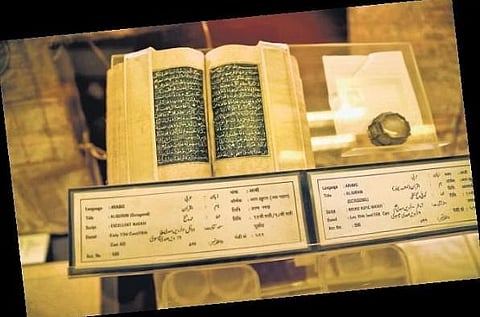

HYDERABAD: Salar Jung Museum hosts some of the most precious miniature paintings that often get overshadowed by a host of other exhibits. An art decoration workshop at the museum focused on basic principles of art, helping people to identify the time period of paintings and manuscripts by their design, colours and content.
In the vast expanse of the Salar Jung Museum in Hyderabad, boasting an impressive 39 galleries, one finds it challenging to fully immerse themselves in each exhibit. The museum proudly holds the distinction of being the largest collection amassed by a single individual in the world. Consequently, visitors often feel compelled to keep progressing through the museum, driven by a combination of curiosity to behold its entirety at once and a belief that old objects may not offer much insight. However, there is a lot that can be discovered through old objects.
When seeking a comprehensive understanding of the social and political fabric that defined a particular era, one can turn to the paintings of that time. These artistic masterpieces offer valuable insights into the lives of individuals and societies, providing a window into the past that words alone cannot convey.
Despite being repositories of immense knowledge, the sections dedicated to miniature paintings and manuscripts within the museum often receive the least appreciation.
These remarkable collections tend to go unnoticed amidst the multitude of exhibits on display. In particular, when considering the captivating realm of miniature paintings, especially those focused on the Deccan region, one is presented with a vivid depiction of the social lives of kings and nobles during the early modern era.
A workshop was organised by INTACH Hyderabad, The Deccan Archive (TDA) and The Hyderabad Walking Company (THWC) to encourage people to look at these miniature paintings and manuscripts a bit more closely than usual. “The idea is to introduce people to fundamental principles of art, to give them a basic set of identifiers that will help them place paintings and manuscripts according to their time periods just by looking at them and also to appreciate the effort involved and beauty in it much more,” said Navin Sigamany, the founder of THWC.
The workshop involved a brief presentation by the two art enthusiasts on essential characteristics of medieval-era manuscripts and early modern paintings and was followed by a visit to each of the galleries displaying them.
Pointing at a 17th-century painting of Abdullah Qutb Shah, shown standing in an enclosure with a group of ladies adorning beautiful pearl jewellery, Sibghat Khan, founder of TDA said, “If you look at the central figure in the painting, you would see the king displayed as the tallest, most influential person in the picture. The king can be identified with a halo around his head, and an eagle perched on his hand suggesting that he is probably headed for shikar because those were the birds used for hunting at that time and a host of vases seen behind him displayed blue in colour depict the porcelain objects imported from China.” Zooming into the painting one would be able to notice the kohl of women’s eyes, the mehendi in the king’s hands and the finest strands of hair standing out from the Turra of his cap.
In another picture, portraying the scene of a caravanserai, one could see a host of actions taking place. In the centre, a man diligently prepares medicine with a pestle and mortar, while those around him eagerly anticipate his concoction. Adjacent to them, a camel is tethered to a coconut tree. In the lower portion, a man kneads dough while observing the animals before him. Meanwhile, in the upper right quarter, a woman can be glimpsed through a window, skillfully making chapatis in the kitchen, with a porcelain bowl placed nearby.
One would wonder how almost three centuries ago, without the use of modern technology, the artists painted such intricate details. “The tools they would use would be as delicate and fine as a single strand of a horse’s hair or a needle,” said Navin. “Moreover, these paintings are the closest you have to the present-day photographs. Even after the cameras arrived, some of the later paintings suggest that there were people still commissioning painters to make such paintings,” he added.
That and the fact that some of the most precious stones such as lapis lazuli, emeralds and metals like gold were used is common to the creation of both paintings and manuscripts. It depicted the wealth of the commissioner but also the art and skill of the painter or the calligraphist. The gold and the precious lapis lazuli would reflect right back at you if you shine some light on the paintings and manuscripts displayed. The outlines and the borders would magically come alive.